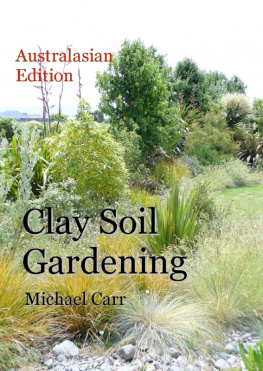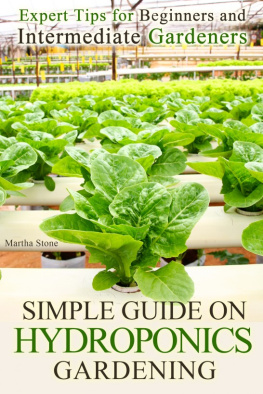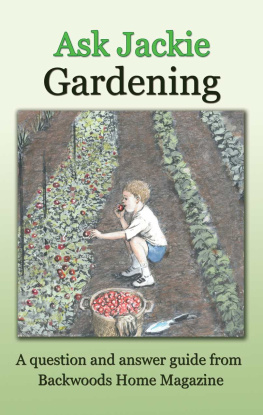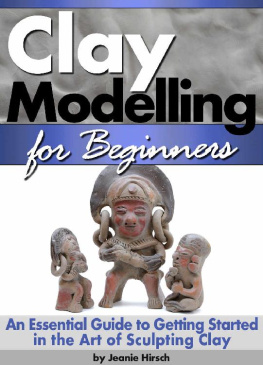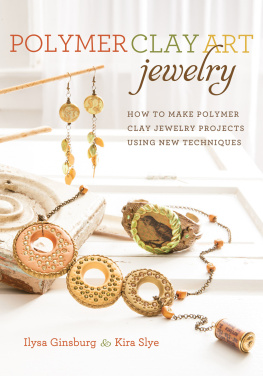Michael Carr - Clay Soil Gardening: Australasian Edition
Here you can read online Michael Carr - Clay Soil Gardening: Australasian Edition full text of the book (entire story) in english for free. Download pdf and epub, get meaning, cover and reviews about this ebook. year: 2012, publisher: Michael Carr, genre: Children. Description of the work, (preface) as well as reviews are available. Best literature library LitArk.com created for fans of good reading and offers a wide selection of genres:
Romance novel
Science fiction
Adventure
Detective
Science
History
Home and family
Prose
Art
Politics
Computer
Non-fiction
Religion
Business
Children
Humor
Choose a favorite category and find really read worthwhile books. Enjoy immersion in the world of imagination, feel the emotions of the characters or learn something new for yourself, make an fascinating discovery.
- Book:Clay Soil Gardening: Australasian Edition
- Author:
- Publisher:Michael Carr
- Genre:
- Year:2012
- Rating:3 / 5
- Favourites:Add to favourites
- Your mark:
- 60
- 1
- 2
- 3
- 4
- 5
Clay Soil Gardening: Australasian Edition: summary, description and annotation
We offer to read an annotation, description, summary or preface (depends on what the author of the book "Clay Soil Gardening: Australasian Edition" wrote himself). If you haven't found the necessary information about the book — write in the comments, we will try to find it.
Clay Soil Gardening: Australasian Edition — read online for free the complete book (whole text) full work
Below is the text of the book, divided by pages. System saving the place of the last page read, allows you to conveniently read the book "Clay Soil Gardening: Australasian Edition" online for free, without having to search again every time where you left off. Put a bookmark, and you can go to the page where you finished reading at any time.
Font size:
Interval:
Bookmark:
Australasian Edition
By Michael Carr
Published by Michael Carr at Smashwords
Copyright 2012 Michael Carr
~
~
Next toinadequate watering, water logging or "wet feet" is the most commonreason why garden plants in temperate regions die or fail tothrive, and water logging occurs most frequently on heavy claysoils. Such soils can present a big (and costly) challenge to theuninitiated. This doesnt mean gardeners confronted with heavy claycant create great gardens, but it does mean they need no-nonsenseadvice on how to deal with the unique challenges of gardening onclay soils and information on which plants are suitable for claygardens.
Unmodified heavy clay soils can be grey,yellow-brown or red in colour and arefamiliar to gardeners in many parts of eastern Australia and NewZealand. They are slow to drain following heavy rain, with greyclays tending to have the worst drainage problems (grey colorationindicates a lack of oxygen in the soil). Clay soils also have ahabit of swinging from one extreme to the other wet, sticky andheavy in winter, to hard as rock and impossible to dig in summer.Since unmodified clay soils have poor drainage, they're also slowto warm up in spring, resulting in slower plant growth and poorgermination of seeds. The plus side of clay soils is they retainmoisture in summer and, compared with free-draining sandy soils,have high nutrient levels. This is because better-drained sandysoils tend to lose more water-soluble nutrients through rain andwatering. To assess the drainage of your soil dig some holes about50 cm deep in various spots and fill them with water. Then leavethem for 24 hours. If the holes havent drained after this timethen your soil has poor drainage which needs to be improved.
The most important ingredient in improvingclay soils is the addition of large amounts of organic matter orhumus. Garden compost, leaf mould, mushroom compost, grassclippings, straw, sawdust, rotted bark, washed seaweed "greenmanure" (crops which are dug into the ground just beforeflowering*) and pine needles are all useful additives but need tobe used in quantity to have much effect on soil structure. Ifbuying compost its much more economical to purchase it by thetrailer load from landscaping suppliers. Buying compost by thebag-full from supermarkets and garden centres is definitely not an economic option forthose with large gardens. Well-rotted animal manure is also anexcellent additive but needs to be used in moderation as animalmanures can contain high levels of salt. When digging over claysoil to add organic matter its best to do so when the ground is ina moist (but not soggy) condition, with spring usually being thebest time. If digging dry ground give it a good soaking with a hosethe night before to soften it up a bit. On heavy, unmodified clayyou may also need a pick or pointed shovel to dig it over as itsdifficult to make much impact on heavy clay with a flat-ended spadeor light fork.
*legumes such as peas and broad beans, whichstore nitrogen on nodules on their roots, make excellent greenmanure crops if dug into the ground after the pods have beenharvested. Crops with long tap roots, such as Japanese daikonradishes, also help to break up clay soils and can either beharvested for kitchen use or dug back into the soil to provideextra humus. Vigorous-growing green manure crops such as lupin andmustard should be dug in just before flowering, as they can causeweed problems if left to run to seed.
Coarse sand or grit is another usefulingredient for improving the structure of clay soils. It has theadvantage of permanently affecting soil structure (organic matterrots down and needs to be replaced on a regular basis, whilenon-organic material like coarse sand pretty much stays in theground forever). However, its best used for treating smaller areaslike herb gardens or rockeries as it take a lot of grit to have asignificant impact on soil structure. Some gardening experts warnagainst using sand for improving clay soils, claiming it canactually make soils harder or heavier. In my experience sand is okas long as a coarse grade is used, and its combined with plenty oforganic matter.
Some clay soils can also be improved by theaddition of gypsum which works in a similar why to lime but doesntaffect soil ph. Gypsum not only creates a more friable soilstructure, but also adds the plant nutrients sulphur (which issometimes slightly deficient in clay soils) and calcium. However,gypsum has some drawbacks. It only works for certain types of claysoils (usually alkaline clays found in low rainfall areas) andtakes several years to take effect. To find out if your soil willbenefit from gypsum, place a small sample of your soil in a glassjar, add water and give it a shake. Then leave it to stand for afew hours and observe how long it takes before the soil particlesstart to settle and the water begins to clear. Next repeat theexercise adding a small amount of gypsum. If the soil particlesstart to clump together and the water begins to clear more quicklythe second time, this indicates the gypsum is binding with thedissolved clay particles, and so adding gypsum to your soil mayhelp to improve its structure.
The addition of charcoal from bonfires canalso be helpful. Charcoal helps to aerate and darken clay soils anddarker soil is quicker to warm up in spring. But always be sure touse charcoal from untreated wood as treated timber can containpoisonous preservatives. Applying large amounts of wood ashes isnot advisable since ashes contain lime which can make soils morealkaline. Small quantities can be useful as a fertiliser forfruiting and flowering crops though, as wood ashes are a goodsource of the plant nutrient potassium.
Yes Im being serious here! Sponges havebeen found to be quite an effective way of helping to reducewater-logging in clay gardens. Chop ordinary, budget householdsponges into small pieces and mix them into the soil around plantswhich are sensitive to poor drainage. The sponge pieces will helpto soak up excess water when the soil is wet, and then slowlyrelease it as the soil dries out. Sponges can also be used as anemergency measure to help protect vulnerable plants from waterlogging during heavy rain.
Where drainage problems are severe, it maybe necessary to create drains to remove surplus water. The simplestoption for improving drainage is to create sump holes at specificspots in the garden where drainage is particularly bad. Sump holesare simply deep holes which are filled in with gravel and coarsesand and then topped off with a few inches of top soil. Ideallythese holes need to be at least a metre deep. Sump holes areparticularly effective when a clay soil forms a shallow pan over afree-draining sub-soil. In such cases the sump hole will puncturethe clay layer and allow trapped water to escape into the sub-soil.Where there is a deep layer of poor-draining clay, it will benecessary to create a continuous drain. Drains can be simple,shallow trenches filled with gravel (also known as French drains)or perforated plastic pipes which are surrounding by gravel andthen covered with a thin layer of top soil. If constructing arelatively long drain it may be necessary to get professional helpto make sure the drain has a precise, even slope that ensures goodwater flow.
Instead of adding drains, another option forimproving drainage is to create raised beds. Raised beds areparticularly good for annual flowers, vegetables and herbs sincethey warm up more quickly in spring and help seeds and seedlingsget off to a good start. Concrete blocks, large bricks or beams ofhard, resinous untreated timber provide good framing materials forraised beds. If treated timber is used it must be lined with thickplastic film to avoid the risk of toxins leaking into the soil. Onthe boundaries of larger gardens raised mounds are a popularoption. These are often used on new, exposed sections to make useof surplus soil from building excavations as well as to provideprivacy and wind protection. When building boundary mounds makesure the sides arent too steep or they will suffer from erosion,mulch will slide off, and plants near the tops of mounds will dryout too much in summer. One drawback of using mounds is they cancreate drainage problems in surrounding areas since water will runoff and head for the nearest low-lying part of the garden.Subsequently, its important to use mounds in moderation and avoidputting clay intolerant plants in low-lying spots near raised bedsor mounds.
Font size:
Interval:
Bookmark:
Similar books «Clay Soil Gardening: Australasian Edition»
Look at similar books to Clay Soil Gardening: Australasian Edition. We have selected literature similar in name and meaning in the hope of providing readers with more options to find new, interesting, not yet read works.
Discussion, reviews of the book Clay Soil Gardening: Australasian Edition and just readers' own opinions. Leave your comments, write what you think about the work, its meaning or the main characters. Specify what exactly you liked and what you didn't like, and why you think so.

